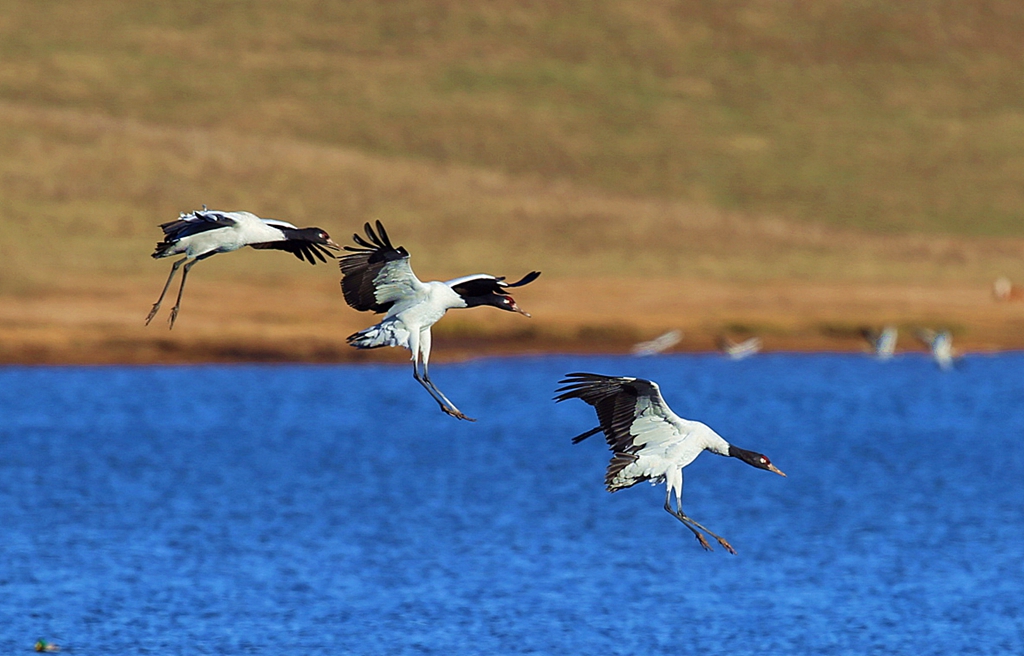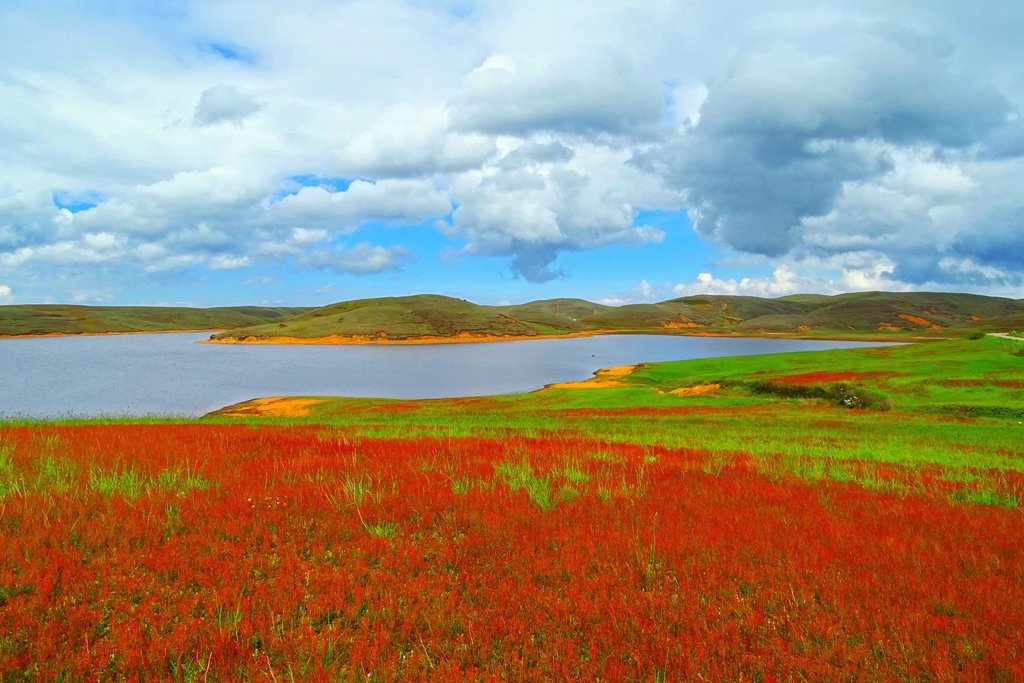Dashanbao: where man, cranes co-exist in harmony
When winter comes, the Dashanbao national nature reserve in northeast Yunnan’s Zhaotong City will present visitors a uniquely mysterious sight: black-necked cranes hovering or gliding on the 3000-meter-high plateau.

The Dashanbao national nature reserve (Yunnan Daily/File photo)
Protecting shared home for folks and cranes
The black-necked crane is native to the Qinghai-Tibetan region, but it prefers to winter in the less cold areas like Dashanbao. In spite of this, its population remained rather small until 1996, when the bird species was put under first-class state protection in China.
The Dashanbao nature reserve features immense grassland on gentle slopes, and together with its 358 alpine plants, marshes and 581 mountain springs, the reserve makes a sound foraging and wintering habitat for 166 bird species.
In early 1990s, local authorities began to issue rules and regulations to conserve wintering birds in the area, which consist of relatively flat mountain tops on the southern bank of the Jinsha river, upper reach of the mighty Chinese mother river of Yangtze.
And over the past 30 years, caring for the cranes and others have gradually become voluntary actions among the 20,000 Han, Miao and Yi ethnic folks there.
“The idea of green development basically means reshaping the development-environment relation, in a bid to resolve the problems that emerged in the coexistence of man and nature,” said Huang Qin, director of the Dashanbao management bureau.
Thanks to unremitted protective efforts, Huang added, the Dashanbao reserve swamp was selected as an internationally significant wetland in December 2004, and it was chosen as one of the top six Chinese wetlands of supreme beauty.
As a major gene pool on the Yunnan-Guizhou plateau, the Dashanbao swamp plays a key role in protecting the wintering wild species, the subalpine bio-diversity and the eco-barrier along the upper reach of Yangtze.

Wintering black-necked cranes hover in the Dashanbao area. (Yunnan Daily/File photo)
Making room for wintering cranes
Back to the early 1980s, locals in the Dashanbao area made a living by growing potatoes, buckwheat, oat and others, but the high altitude and low temperature produced tiny outcomes.
To grow other crops for higher yields, swamps were turned into arable dry land, and locals also reared more animals in the fields, resulting in over grazing. Due to these practices, the habitat for wintering cranes shrunk those days.
Starting in 1988, the migrating black-necked cranes began to be publicized and recognized as rare species, inviting in crowds of international scientists, photographers and tourists, who also posed challenges to local environment.
Accordingly, the Dashanbao county-level nature reserve was founded in 1990, which was ungraded all the way to a national reserve for the black-necked cranes in the ensuing years. Since 2003, Dashanbao has rolled out a series of rules and regulations on protecting the crane habitat.
“The environment carrying capacity of Dashanbao is quite limited. If we hadn’t taken actions, the backpackers’ coming would have resulted in the cranes’ leaving,” said Huang, adding that the Dashanbao tourist projects were suspended in 2019. Now individual tourists and their vehicles are mostly not allowed to enter the protected areas.
To make more living room for the birds, forest departments have invested hundreds of million yuan in restoring 20,000 mu marshes. Using the poverty-alleviation opportunities, a total of 7,923 villagers within the reserve were resettled in the urban areas in 2020, and more grassland was offered to the cranes and other wild species.
So far, the number of black-cranes in the Dahsnbao reserve has increased from 200 in 1990 to 1,983 in December 2020, with the acreage of the wetland going up from 3,150 ha to 5,958 in the same period.

The Dashanbao national nature reserve (Yunnan Daily/File photo)
Harmonious co-existence of man, cranes
“I’ll fly to the reserve in the ninth lunar month, and return next year when it’s warm. Do you know Dashanbao is my dreamy home, for which I’d like to pray lifelong?” In the song Dream-making Dashanbao, the lyric was written in the tone of a crane.
Indeed, the affectionate song shows local folks’ love to the black-necked cranes. Dong Yinglan and her daughter-in-law Chen Guanghui are representatives among local conservationists.
Shortly after the founding of the reserve in 1990, Dong, aged 69 at present, volunteered to feed and count the cranes, and in 2003 Chen followed Dong’s step in caring for the birds. Now 18 years has gone by.
“I even dreamed of their arrival in autumn, but I would feel at loss when they left for the north,” said Chen Guanghui, who adopted an injured crane for six years (2008-2014). As time went by, a certain bond was formed between Chen and the cranes. A whistle by Chen would make herself surrounded by crowds of the black-necked cranes.
On January 4, 2012, the temperature in Dashanbao dropped to minus 19℃, and the Dahaizi reservoir was frozen. During their routine patrol, Zheng Yuanjian and Zhao Zijiao, both staffers at the reserve, noticed that six black-necked cranes were trapped. Two of them had fallen into the ice holes.
"Hurry and rescue!" Zheng and Zhao braved the cold and entered the chest-deep icy lake, helping out four trapped cranes in time. The two injured cranes were rescued via a 40-day treatment.
By the end of 2020, the reserve staffers and locals have rescued over 90 injured cranes, 48 of which returned to nature upon recovery, according to incomplete data.
"To protect the crane and others is to conserve home for human survival." After 30 years of interaction, locals gradually realized the importance of caring for the eco-environment, and they joined in the actions of protecting black-necked cranes and other migrant birds. Man and cranes now co-exist harmoniously in the Dashanbao reserve.

Wintering black-necked cranes rest in the Dashanbao reserve. (Yunnan Daily/File photo)
Reporting by Cai Houyou and Shen Xun (Yunnan Daily); Trans-editing by Wang Shixue